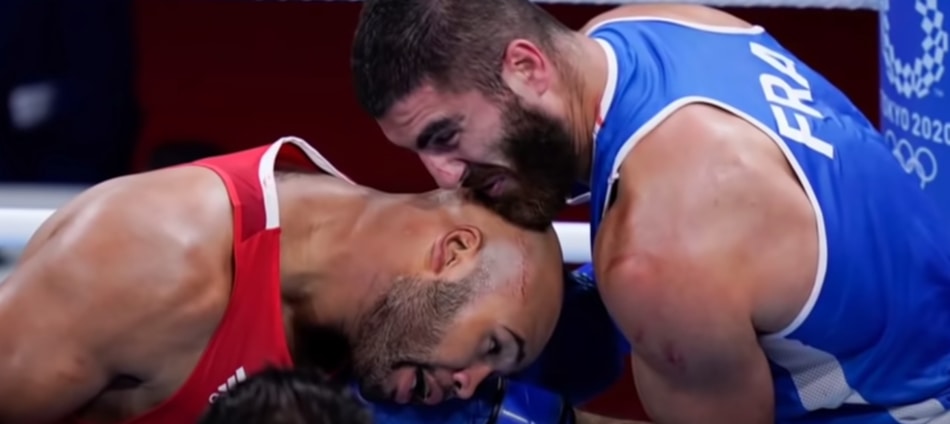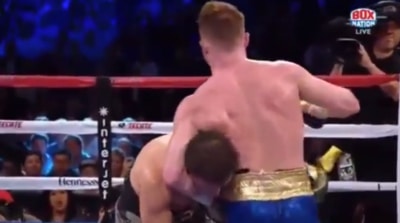
Due to the blow’s unpredictability and mechanics, a headbutt can be truly devastating. You might be wondering, then, whether headbutting is allowed inside a boxing ring.
Headbutts are not legal in boxing. A strike with the head is much likelier to cut and damage your opponent than a punch that is cushioned by gloves and hand wraps. The human head is hard and even sharp in places, whereas the padded area of boxing gloves is soft and flat. Therefore, the potential impact of a headbutt is much greater than that of a punch.
But what happens if you throw a headbutt in a boxing match? Are there any famous examples of this? Moreover, are headbutts legal in any other combat sport? And what are the legal ways to use your head to gain an advantage when boxing? Let’s dive into those questions!
Consequences of Headbutting in Boxing
Before we discuss the consequences of headbutting someone in a boxing ring, it’s important to note that intention does not absolve you of responsibility. Even if the headbutt was unintentional (i.e. you were merely attempting to slip/roll under a shot, change levels or close the distance), you can still be penalized.
Headbutting can have serious implications for both parties involved. The recipient can take significant damage, as this strike is prone to delivering cuts or damaging the bony parts of the face. Meanwhile, the fighter who threw the headbutt will need to answer for their actions as well.
The most common outcome is a point deduction, but if there have been multiple offenses throughout the fight or the act is considered flagrant, the referee may disqualify you outright.
Generally speaking, a fight that is ended because of a headbutt will go to a technical decision. The judges will hand over their scorecards and the fighter who finds themselves ahead on points at that moment will earn the victory.
In order for a fight to end in a technical decision though, it must either go beyond the fourth round or the halfway point of its scheduled duration (e.g. six rounds in a 12-round match). A fight that doesn’t reach this point will be declared a technical draw.
Since you’re not free and clear if the headbutt was accidental, it’s vital for both safety reasons and the outcome of the fight to remain in control of your head position at all times.
Legal Ways of Using your Head in Boxing
Though striking with your head is forbidden in boxing, you can still use that part of your body to gain an advantage.
In clinch or in-fighting situations, you can lean your head against your opponent to control their frame. This crowds their punches and smothers their offense. Moreover, if you have leverage from your head position, you can manipulate your opponent’s upper body in order to create an opening for your attack. A well-timed shift in any direction could provide you with the space required to land a solid shot.
If you happen to be tired, you can even initiate a clinch and take a breather until the referee breaks it up. Just make sure your chin is tucked in. Otherwise, you may be on the receiving end of a nasty blow.
However, you need to be cautious when employing this tactic. Wait until you’re close enough to your opponent or a clinch has already started to use your head this way. If you’re simply swinging your head into an exchange, things can get ugly in a hurry.
Famous Examples of Headbutts in Boxing
Even though headbutts are illegal in boxing, there have been multiple cases in the sport over the years.
Evander Holyfield
When it comes to this specific topic, the most notorious fighter is the former heavyweight champion, Evander Holyfield. He was so adept at “accidentally” headbutting his opponent that his head was dubbed his third fist.
During his infamous rematch against Mike Tyson in 1997, he continually swung his head into Tyson’s as a means of stifling his opponent’s offensive setups. This irritated Tyson so much that he eventually bit Holyfield’s right ear in the third round.
The referee deducted two points from Tyson, but when the action continued, Tyson was still seeing red and bit Holyfield’s left ear. This resulted in a disqualification. It is arguably the most popular boxing moment of the 1990s.
In his 2002 fight against Hasim Rahman, Holyfield was up to his same old tricks. Instead of ducking away from Rahman’s punches, he repeatedly dipped his head into his opponent’s. Since the referee didn’t appear to pick up on these infractions, Holyfield kept going back to the well until a nasty hematoma appeared above Rahman’s left eye in the eighth round.
It is one of the most gruesome sights in boxing history. Despite all these headbutts, Holyfield was still awarded the victory by technical decision.
Julio Cesar Chavez vs Frankie Randall
Another polarizing headbutt was seen in the rematch between light welterweights Julio Cesar Chavez and Frankie Randall in 1994. Once again in the eighth round, Chavez missed with a right and stumbled forward as Randall stepped in to land a body shot. With both fighters leaning in, there was a clash of heads.
Chavez immediately reacted to the cut above his right eye. The fight went to the judges, who ultimately scored it as a win for Chavez despite many members of the media and the viewing audience believing Randall was ahead when the fight was stopped.
Floyd Mayweather Jr. vs Victor Ortiz
One of the most blatant headbutts occurred in the 2011 welterweight title bout between Floyd Mayweather Jr. and Victor Ortiz. Perhaps frustrated by how often his opponent was landing with his right hand, Ortiz cornered Mayweather in the fourth round and launched his head upward at Mayweather’s.
There was no disguising this blow. Ortiz jumped into it and was rightfully deducted a point for his actions.
After apologizing for his mistake, Ortiz swiftly received his comeuppance in a bizarre turn of events. The referee signaled for the fight to continue but was looking away from the action. Mayweather approached Ortiz, threw a left hook, and then ended the fight with a clean right hand.
Andrew Moloney and Joshua Franco
There have been some recent headbutt-related controversies too.
First, there was a hotly contested result in the November 2020 rematch between Andrew Moloney and Joshua Franco. The fight was ruled a no-contest following a supposed headbutt by Moloney, but replays don’t seem to corroborate this view. Franco put an end to the debate by claiming the rubber match via unanimous decision in August 2021.
Mourad Aliev vs Frazer Clarke
In a quarterfinal super heavyweight fight at the 2021 Olympics, Mourad Aliev was disqualified for a clash of heads that opened up cuts over the eyes of his opponent Frazer Clarke. He protested the decision afterward to no avail.
So if you couldn’t already tell, most fighters aren’t as lucky—or maybe as crafty—as Holyfield when it comes to headbutts. There’s no telling how the judges will see the incident. As such, you would be wise not to throw one.
Combat Sports Where Headbutts are Legal
As brutal as they may seem, headbutts are actually legal in several combat sports.
Lethwei
Lethwei (aka Burmese boxing) is the martial art that is best known for allowing headbutts. This is a brutal sport that is very similar to Muay Thai but more brutal. It’s virtually bare-knuckle, as fighters only wear tape and gauze on their hands. Another brutal rule is that a fighter’s corner can revive their fighter one time after a knockout and put them back into the fight. Watch a few clips and you’ll see just how violent it can be:
Kudo
Kudo is one of the rare forms of Karate that permits the use of strikes with the head. As noted on Wikipedia, the idea behind this martial art was to create “a realistic and versatile fighting style that encompassed effective offensive and defensive techniques including head punches, elbows, headbutts, throws, and joint-locks from Judo combined with other ground fighting techniques.”
If the goal is to simulate real fighting scenarios, nothing is off-limits. Naturally, that includes headbutting.
Vale Tudo and Muay Boran
Elsewhere, headbutts are allowed in Vale Tudo, a Brazilian combat sport with few rules. It predates mixed martial arts and is generally perceived as a more primitive and violent sport. Similarly, Thai martial art Muay Boran—a predecessor of Muay Thai—allows headbutts. In addition to standup striking, grappling and ground fighting are permitted.
Combat sambo
Combat sambo, which is familiar to MMA fans because of former undefeated UFC lightweight champion Khabib Nurmagomedov’s background in the sport, also allows headbutting. The name of this form of Soviet wrestling translates to “self-defense without weapons.”
Finally, headbutts are also permitted in:
- Capoeira – A Brazilian martial art that famously combines striking with elements of dance and acrobatics.
- Testa – An Eritrean martial art.
- Krav Maga – An Israeli self-defense system that blends elements of boxing, wrestling, Judo, Aikido and Karate.
A trip down the YouTube rabbit hole reveals just how devastating a headbutt can be in these sports. It may be an effective act of self-defense, but its tendency to open up cuts and damage opponents far worse than gloves ever could make it ill-suited to the sport of boxing.
Recap
Headbutting is not legal in boxing because the skull is as hard as a rock, which obviously makes it a much more dangerous weapon than padded gloves. It’s not some coincidence that even seemingly light headbutts open up cuts and end fights on a regular basis.
With that said, this move is allowed in a number of other combat sports. If you’re familiar with them, you’ve seen how violent headbutts can be.
You can still use your head in boxing, but more so as a way to control your opponent’s posture rather than as a strike. By gaining leverage with your head leaned against your opponent, you can gain the upper hand inside and find a home for short hooks and uppercuts. Fights don’t unfold exclusively at long range, so it’s worth drilling these concepts at the gym and preparing for such situations.



